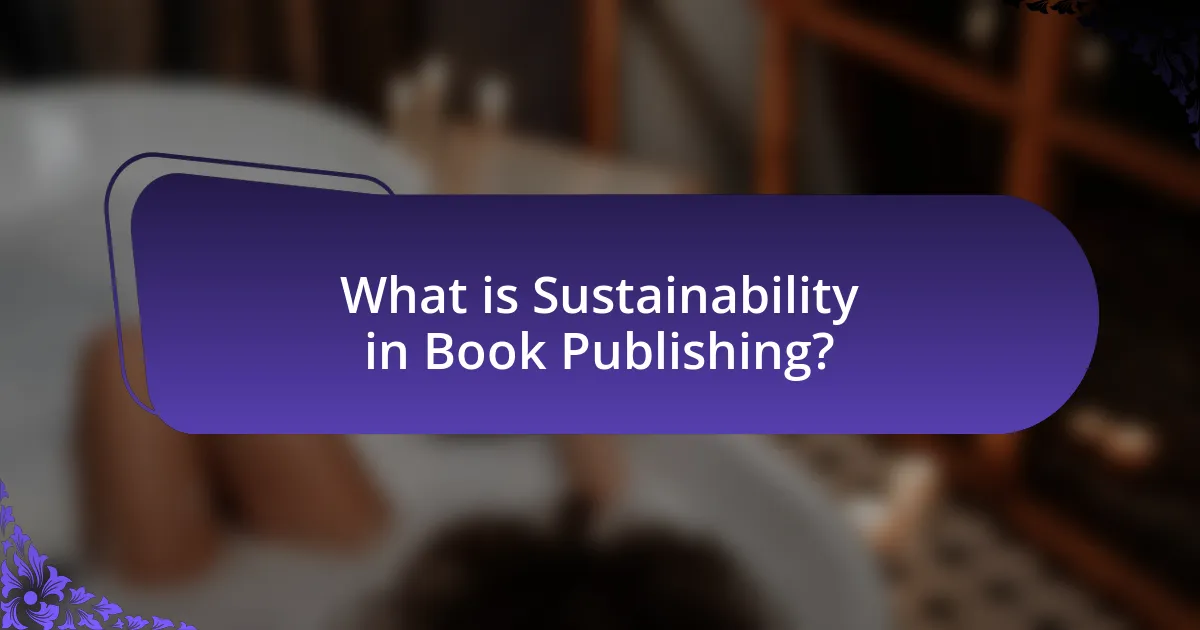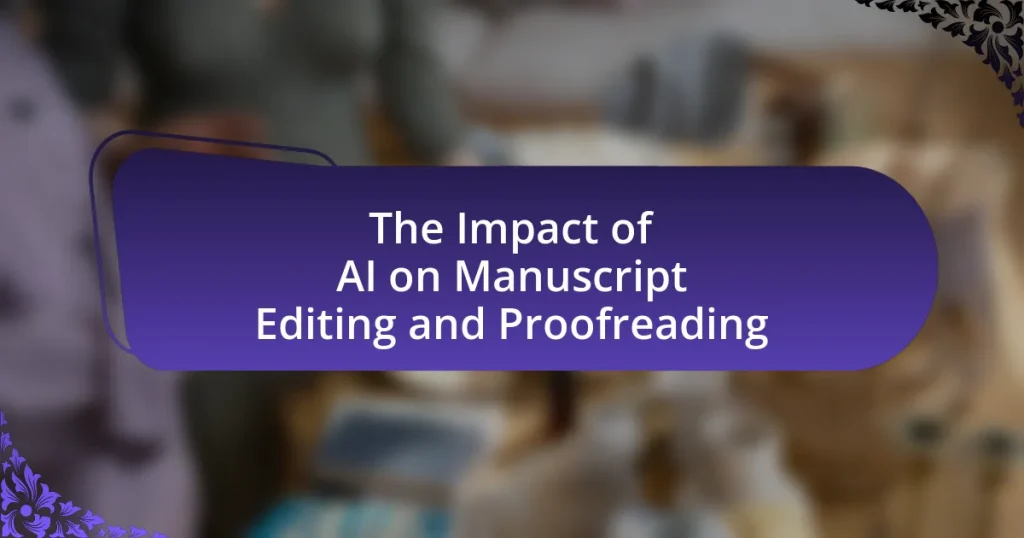Sustainability in book publishing encompasses practices aimed at reducing the environmental impact of book production and distribution. This article explores the definition of sustainability within the industry, highlighting key principles such as responsible sourcing, waste minimization, and energy efficiency. It addresses the importance of sustainability in mitigating deforestation and carbon emissions, while also examining current challenges faced by publishers. The article further discusses eco-friendly practices, innovations like digital publishing and print-on-demand technology, and the role of consumer demand in promoting sustainable initiatives. Additionally, it outlines best practices for publishers and potential partnerships that can enhance sustainability efforts in the publishing sector.

What is Sustainability in Book Publishing?
Sustainability in book publishing refers to the practices and strategies that aim to minimize the environmental impact of producing and distributing books. This includes using eco-friendly materials, such as recycled paper and vegetable-based inks, as well as implementing energy-efficient processes in printing and distribution. According to a 2021 report by the Book Industry Environmental Council, adopting sustainable practices can significantly reduce carbon footprints, with some publishers reporting a decrease of up to 30% in emissions through such initiatives.
How is sustainability defined in the context of book publishing?
Sustainability in the context of book publishing is defined as the practice of producing books in a manner that minimizes environmental impact while promoting social responsibility and economic viability. This includes using eco-friendly materials, such as recycled paper and vegetable-based inks, implementing energy-efficient production processes, and ensuring ethical labor practices throughout the supply chain. For instance, the Book Industry Environmental Council has reported that adopting sustainable practices can significantly reduce carbon footprints and resource consumption in the publishing industry.
What are the key principles of sustainability in publishing?
The key principles of sustainability in publishing include responsible sourcing of materials, minimizing waste, energy efficiency, and promoting digital alternatives. Responsible sourcing involves using recycled or sustainably sourced paper, which reduces deforestation and environmental impact. Minimizing waste focuses on reducing excess production and utilizing print-on-demand technologies, which can significantly decrease unsold inventory. Energy efficiency is achieved through optimizing production processes and using renewable energy sources in printing facilities. Promoting digital alternatives, such as e-books, reduces the need for physical materials and transportation, further lowering the carbon footprint associated with publishing. These principles collectively contribute to a more sustainable publishing industry.
Why is sustainability important for the publishing industry?
Sustainability is important for the publishing industry because it addresses environmental concerns associated with paper production, waste management, and carbon emissions. The industry significantly contributes to deforestation, with approximately 30% of the world’s harvested trees used for paper products. By adopting sustainable practices, such as using recycled materials and eco-friendly inks, publishers can reduce their ecological footprint. Furthermore, consumer demand for environmentally responsible products is rising, with 66% of global consumers willing to pay more for sustainable brands, indicating that sustainability can enhance market competitiveness and brand loyalty in the publishing sector.
What are the current challenges facing sustainability in book publishing?
The current challenges facing sustainability in book publishing include high carbon emissions from production processes, reliance on non-renewable resources, and waste generated from unsold books. The book publishing industry is responsible for approximately 2% of global carbon emissions, primarily due to paper production and transportation. Additionally, the use of virgin paper contributes to deforestation, while the disposal of unsold books leads to significant landfill waste. These factors hinder the industry’s ability to adopt eco-friendly practices and innovate sustainable solutions effectively.
How do traditional publishing practices impact the environment?
Traditional publishing practices significantly impact the environment through resource consumption and waste generation. The production of books involves the use of paper, which contributes to deforestation; approximately 30% of the world’s forests are used for paper production. Additionally, the printing process consumes energy and water, with estimates suggesting that producing a single book can require up to 7.5 gallons of water. Furthermore, traditional publishing generates substantial waste, as unsold books often end up in landfills, contributing to environmental degradation. These practices highlight the need for more sustainable approaches in the publishing industry.
What barriers do publishers face in adopting sustainable practices?
Publishers face several barriers in adopting sustainable practices, primarily including high costs, lack of awareness, and limited access to sustainable materials. High costs associated with eco-friendly materials and processes can deter publishers from making the switch, as traditional methods often appear more economically viable. Additionally, a lack of awareness about sustainable options and their benefits can lead to resistance within the industry, as many publishers may not fully understand the long-term advantages of adopting such practices. Furthermore, limited access to sustainable materials can hinder the implementation of eco-friendly initiatives, as not all suppliers offer green alternatives, making it challenging for publishers to source the necessary resources.

What eco-friendly practices are being implemented in book publishing?
Eco-friendly practices in book publishing include the use of recycled paper, soy-based inks, and sustainable sourcing of materials. Publishers are increasingly opting for paper made from post-consumer waste, which reduces deforestation and energy consumption. Additionally, soy-based inks are less harmful to the environment compared to traditional petroleum-based inks, as they emit fewer volatile organic compounds. Many publishers also implement print-on-demand technology, which minimizes waste by producing books only as needed, thus reducing excess inventory. These practices collectively contribute to a more sustainable publishing industry, aligning with global efforts to reduce environmental impact.
How are publishers reducing their carbon footprint?
Publishers are reducing their carbon footprint by implementing sustainable practices such as using recycled paper, optimizing print runs, and adopting digital publishing methods. For instance, many publishers now source paper from sustainably managed forests, which helps minimize deforestation and carbon emissions associated with paper production. Additionally, optimizing print runs reduces waste by producing only the necessary number of copies, thereby lowering energy consumption and emissions during printing and distribution. The shift towards digital publishing further decreases the carbon footprint by eliminating the need for physical materials and transportation, as e-books and online content require significantly less energy to produce and distribute.
What role does digital publishing play in sustainability?
Digital publishing significantly contributes to sustainability by reducing the environmental impact associated with traditional print publishing. It eliminates the need for paper, ink, and physical distribution, which collectively account for substantial resource consumption and carbon emissions. For instance, a study by the Green Press Initiative indicates that digital formats can save approximately 1.5 trees for every 1,000 e-books published, highlighting the direct ecological benefits of shifting to digital mediums. Additionally, digital publishing allows for more efficient updates and revisions, minimizing waste from unsold printed copies. Thus, digital publishing serves as a crucial mechanism for promoting sustainable practices within the book publishing industry.
How can print-on-demand technology contribute to eco-friendliness?
Print-on-demand technology contributes to eco-friendliness by significantly reducing waste associated with traditional printing methods. Traditional printing often involves producing large quantities of books, leading to excess inventory that may end up in landfills. In contrast, print-on-demand allows for books to be printed only when ordered, minimizing overproduction and waste. According to a study by the Book Industry Study Group, print-on-demand can reduce paper waste by up to 50% compared to conventional printing practices. Additionally, this technology often utilizes digital printing methods that consume less energy and produce fewer emissions, further enhancing its environmental benefits.
What materials are being used to promote sustainability in book production?
Sustainable book production utilizes materials such as recycled paper, soy-based inks, and biodegradable plastics. Recycled paper reduces the need for virgin pulp, conserving forests and decreasing energy consumption; for instance, using recycled paper can save up to 60% of energy compared to producing new paper. Soy-based inks are derived from renewable resources and are less harmful to the environment than traditional petroleum-based inks, as they emit fewer volatile organic compounds (VOCs). Additionally, biodegradable plastics are increasingly used for book covers and packaging, which break down more easily in the environment compared to conventional plastics. These materials collectively contribute to a more sustainable publishing industry by minimizing environmental impact and promoting resource conservation.
What types of paper are considered eco-friendly?
Eco-friendly paper types include recycled paper, bamboo paper, and hemp paper. Recycled paper is made from post-consumer waste, reducing the need for virgin fibers and minimizing deforestation. Bamboo paper is produced from fast-growing bamboo, which requires less water and no pesticides, making it a sustainable alternative. Hemp paper, derived from the hemp plant, is known for its durability and requires fewer chemicals during production compared to traditional wood pulp paper. These types of paper contribute to environmental sustainability by reducing waste and conserving natural resources.
How do alternative inks and adhesives impact sustainability?
Alternative inks and adhesives significantly enhance sustainability by reducing environmental impact through the use of renewable resources and lower toxicity. These alternatives often utilize plant-based materials, which decrease reliance on petroleum-based products, thereby minimizing carbon emissions associated with production. For instance, soy-based inks are known to produce less volatile organic compounds (VOCs) compared to traditional inks, contributing to improved air quality. Additionally, eco-friendly adhesives often contain fewer harmful chemicals, which reduces the risk of pollution during manufacturing and disposal. Studies indicate that adopting these sustainable materials can lead to a substantial decrease in the ecological footprint of the publishing industry, promoting a healthier environment.

What innovations are shaping the future of sustainable book publishing?
Innovations shaping the future of sustainable book publishing include the use of eco-friendly materials, digital publishing technologies, and print-on-demand services. Eco-friendly materials, such as recycled paper and vegetable-based inks, reduce environmental impact by minimizing deforestation and chemical usage. Digital publishing technologies, including e-books and audiobooks, decrease the need for physical resources, leading to lower carbon footprints. Print-on-demand services allow publishers to produce books only as needed, significantly reducing waste associated with overproduction. These innovations collectively contribute to a more sustainable publishing industry by addressing resource consumption and waste management.
How are new technologies influencing eco-friendly practices?
New technologies are significantly enhancing eco-friendly practices by enabling more efficient resource management and reducing waste in various industries, including book publishing. For instance, digital printing technologies allow for print-on-demand services, which minimize excess inventory and paper waste. Additionally, advancements in sustainable materials, such as biodegradable inks and recycled paper, are being adopted to lessen environmental impact. According to a study by the Green Press Initiative, the use of recycled paper can reduce greenhouse gas emissions by up to 50% compared to traditional paper production. These innovations collectively contribute to a more sustainable approach in the publishing sector, aligning with broader environmental goals.
What advancements in printing technology support sustainability?
Advancements in printing technology that support sustainability include the development of eco-friendly inks, digital printing methods, and the use of recycled materials. Eco-friendly inks, such as those made from vegetable oils, reduce harmful emissions and are less toxic than traditional petroleum-based inks. Digital printing methods minimize waste by allowing for print-on-demand services, which significantly decrease overproduction and excess inventory. Additionally, the use of recycled paper and sustainable sourcing practices in the production of printing materials further enhances the environmental benefits, as it reduces deforestation and conserves resources. These advancements collectively contribute to a more sustainable printing industry.
How is artificial intelligence being used to enhance sustainable practices?
Artificial intelligence is being used to enhance sustainable practices by optimizing resource management and reducing waste in various industries, including book publishing. For instance, AI algorithms analyze data to improve supply chain efficiency, enabling publishers to minimize excess inventory and reduce carbon footprints. A study by McKinsey & Company found that AI can lead to a 20-30% reduction in operational costs through better demand forecasting and inventory management. Additionally, AI-driven tools assist in digital printing technologies, allowing for print-on-demand services that significantly decrease paper waste. These applications demonstrate how AI contributes to more sustainable practices by promoting efficiency and reducing environmental impact.
What role do consumers play in promoting sustainability in publishing?
Consumers play a crucial role in promoting sustainability in publishing by influencing demand for eco-friendly products and practices. Their purchasing decisions can drive publishers to adopt sustainable materials, such as recycled paper and environmentally friendly inks, as well as to implement responsible sourcing and production methods. For instance, a 2021 survey by the Book Industry Study Group found that 70% of consumers prefer to buy books from publishers that demonstrate a commitment to sustainability. This consumer preference encourages publishers to prioritize sustainable practices, ultimately leading to a more environmentally responsible industry.
How can readers support eco-friendly publishing initiatives?
Readers can support eco-friendly publishing initiatives by choosing to purchase books from publishers that prioritize sustainable practices. This includes selecting titles printed on recycled paper, opting for digital formats to reduce paper usage, and supporting independent publishers that implement environmentally friendly production methods. According to a 2021 study by the Book Industry Environmental Council, publishers that adopt sustainable practices can significantly reduce their carbon footprint, making consumer choices impactful in promoting eco-friendly publishing.
What impact does consumer demand have on sustainable practices?
Consumer demand significantly influences sustainable practices by driving companies to adopt eco-friendly methods to meet customer expectations. As consumers increasingly prioritize sustainability, businesses in the book publishing industry are compelled to implement practices such as using recycled materials, reducing carbon footprints, and adopting digital formats. For instance, a 2021 survey by Nielsen reported that 73% of global consumers would change their consumption habits to reduce environmental impact, highlighting the direct correlation between consumer preferences and sustainable practices. This shift in demand encourages publishers to innovate and invest in sustainable technologies, ultimately leading to a more environmentally responsible industry.
What are some best practices for publishers aiming for sustainability?
Publishers aiming for sustainability should adopt practices such as using eco-friendly materials, implementing digital publishing options, and optimizing supply chains for reduced carbon footprints. Utilizing recycled paper and vegetable-based inks minimizes environmental impact, while digital formats decrease paper usage and distribution emissions. Additionally, optimizing supply chains by sourcing materials locally can significantly lower transportation emissions, contributing to overall sustainability. These practices are supported by research indicating that the publishing industry can reduce its carbon footprint by up to 30% through such measures.
How can publishers effectively measure their sustainability efforts?
Publishers can effectively measure their sustainability efforts by utilizing key performance indicators (KPIs) such as carbon footprint analysis, paper sourcing metrics, and waste reduction statistics. These KPIs provide quantifiable data that reflects the environmental impact of publishing activities. For instance, a study by the Book Industry Environmental Council found that measuring carbon emissions associated with printing and distribution can help publishers identify areas for improvement, leading to a reduction in overall environmental impact. Additionally, tracking the percentage of recycled or sustainably sourced paper used in publications allows publishers to assess their commitment to eco-friendly materials. By regularly analyzing these metrics, publishers can create actionable strategies to enhance their sustainability practices and report progress transparently to stakeholders.
What partnerships can enhance sustainability in the publishing industry?
Collaborations between publishing companies and sustainable paper suppliers can significantly enhance sustainability in the publishing industry. By partnering with suppliers who utilize recycled materials and sustainable forestry practices, publishers can reduce their environmental impact. For instance, companies like Mohawk Fine Papers have established partnerships that focus on producing paper from 100% recycled content, which minimizes deforestation and waste. Additionally, collaborations with organizations that promote digital publishing can further decrease the carbon footprint associated with traditional print methods. Research indicates that transitioning to digital formats can reduce paper consumption by up to 80%, thereby supporting sustainability goals in the industry.



